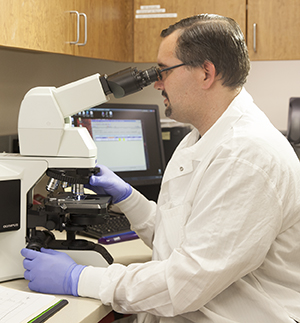Anal Cancer: Diagnosis
How is anal cancer diagnosed?
If your healthcare provider thinks you might have anal cancer, certain exams and tests will be needed to be sure. Diagnosing anal cancer starts with your healthcare provider asking you questions. You'll be asked about your health history, your symptoms, risk factors, and family history of disease.
A physical exam will be done. This includes a digital rectal exam (DRE). During a DRE, your healthcare provider puts a gloved, lubricated finger into your anus and rectum. The inside of the anus and the lower part of your rectum can be checked. Tissue changes might be felt, like hard or lumpy areas.
What tests might I need?
If your healthcare provider feels anything abnormal during a DRE, or if you have symptoms that could be caused by anal cancer, tests will be done to learn more. One or more of these tests might be used:
-
Anoscopy. For this test, your healthcare provider puts a short, lighted tube (called an anoscope) into your anus to look at it and the lining of your lower rectum. The tube is about 3 to 4 inches long. It's lubricated before it's put in. You're awake for this, and it usually doesn't hurt.
-
Proctoscopy. This test is done using a longer lighted tool (a proctoscope) to look at the inside of your anus and rectum. The lower part of your large intestine (called the sigmoid colon) can also be seen. The proctoscope is about 10 inches long. Again, the tube is lubricated before it's put in. You may need to use laxatives to empty your bowels before this test. Medicines might be used to make you sleepy during a proctoscopy. Sometimes tiny pieces of changed tissue can be taken out with tools inside the proctoscope. This is called a biopsy.
-
Colonoscopy. This test uses a longer flexible tube that can see the anus, rectum, and entire colon. You will need to take laxatives before this test to clean out the colon. And you will typically be given medicine to make you sleepy so you will not feel anything. Biopsies can be taken through the endoscope if anything suspicious is seen.
-
Biopsy. If your provider sees any tissue changes that could be cancer, a biopsy may be needed. During a biopsy, your provider takes a small piece (called a sample) of tissue from your anus. The tissue is sent to a lab. There, it’s checked under a microscope and tests are done by a pathologist. This is a doctor who specializes in diagnosing diseases by looking at body tissues and fluids. A biopsy is the only way to know for sure if a change seen in the anus is cancer (malignant) or not cancer (benign).

Getting your test results
When your healthcare provider has your biopsy results, they will contact you. You might want to ask how long it might take to get the results. If anal cancer is found, your provider will talk with you about your next steps, such as other tests you may need. Make sure you understand the results and what follow-up you need.
Online Medical Reviewer:
Robyn Zercher FNP
Online Medical Reviewer:
Susan K. Dempsey-Walls RN
Date Last Reviewed:
9/1/2025
© 2025 The StayWell Company, LLC. All rights reserved. This information is not intended as a substitute for professional medical care. Always follow your healthcare provider's instructions.